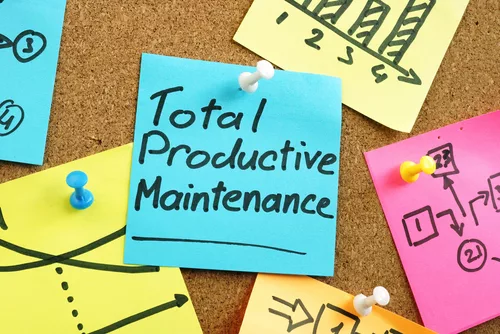- Posted on
- Kortney Murray
- 0
Every business has a unique maintenance plan for its fixed assets. While some businesses dedicate certain resources and employees to asset maintenance activities, others adopt a more holistic design. This holistic design is called total productive maintenance.
Total productive maintenance is a maintenance strategy where all employees take part in maintaining assets within the organization. This method offers different benefits that make it one of the best business strategies. But, how exactly does it work? Below is everything you need to know about total productive maintenance.

What Is Total Productive Maintenance?
The idea behind total productive maintenance is to have an “all hands on deck” approach. This maintenance strategy blurs the lines between employees’ roles in administration, production, and maintenance, ensuring they work together to maintain a company’s assets.
Total productive maintenance, or TPM, is the process of involving all employees within an organization in the maintenance of the organization’s assets. Other than employees, total production maintenance involves using machines and equipment to make production a bit more efficient.
In other words, total productive maintenance aims to achieve better production by involving all employees in maintaining assets. Total productive maintenance emphasizes proactive and preventative maintenance strategies. It does this to attain perfect production with fully-maintained assets.
Put simply, total productive maintenance aims for:
- Zero asset breakdown
- No interruptions of production
- No slow-moving assets
- No defects
- No safety.
With total productive maintenance, businesses aim to reduce downtime while simultaneously increasing productivity. Total productive maintenance channels the strengths of proactive and preventive maintenance strategies to achieve its goals.
Understanding Total Productive Maintenance
To understand TPM, it is first important to understand the intricacies of the process. Why is it done? How is it done? Total productive maintenance works based on the five “S”. Without the five S being in order, a productive maintenance plan can’t be successful.
The 5S foundation includes:
- Sort or organize: Sort through all assets to determine which is used frequently and which is not. The one’s used frequently undoubtedly play a huge role in business operations and should be kept closer to facilitate easy use. Conversely, the assets not used as often should be stored further away than the rest. During this process, assets should be sorted based on their importance.
- Systemize or orderliness: It is essential to keep similar assets together. However, it is also necessary to ensure every asset has a unique location. In other words, assets should have one place to store, and none should be out of order.
- Shine or cleanliness: Cleanliness is an essential part of any business. However, it is also an important part of total productive maintenance. Maintenance is more difficult to perform in a dirty environment and on dirty assets. Without cleanliness, it becomes difficult to assess assets for maintenance and identity the underlying repair needs.
- Standardize: ensuring every process is up to standard is the next step in creating a flawless total productive maintenance process. The workplace should be brought to standard by labeling assets and creating processes where there are none.
- Sustain: The first four steps must be continuously reapplied to ensure the sustenance of the processes. By continuously performing all these steps, a business can easily sustain total productive maintenance.
Pillars of Total Productive Maintenance
There are eight pillars of total productive maintenance. These pillars are the basis of the maintenance strategy and focus on using proactive and preventive techniques to make equipment more reliable. The eight pillars of TPMinclude:
1. Autonomous Maintenance
Autonomous maintenance puts the responsibility of routine asset maintenance in the hands of the operators. It ensures that operators are trained to attend to routine maintenance services such as cleaning, lubricating, and inspecting. Autonomous maintenance is great because it gives operators a sense of responsibility and ownership of the equipment.
This sense of responsibility helps operators learn more about the machine, thereby increasing their knowledge about the handling and sustenance of that machine. Implementing autonomous maintenance also ensures the machine is always clean, lubricated, and in excellent condition.
This makes it easier to identify faults faster while keeping the risk of damage minimal. Because autonomous maintenance focuses on teaching operators to maintain the machines, it reduces the need for maintenance personnel. This ensures maintenance personnel can take on higher-level tasks.
2. Planned Maintenance
Planned maintenance involves scheduling maintenance services according to the machine’s failure rates. This maintenance strategy involves studying asset metrics such as historical breakdown and failure rates and then scheduling maintenance according to this data.
In other words, the frequency of maintenance is based on the machine’s performance and inefficiencies. Planned maintenance lets businesses create a routine. This way, they can schedule a maintenance service when the equipment is idle without interrupting operations.
By implementing this approach, planned maintenance reduces asset downtime. This maintenance process also reduces inventory by better controlling failure-prone equipment parts. It also mitigates constant breakdowns, ensuring better asset uptime as the asset reaches and sustains maximum potential.
3. Focused Improvement
Focused Improvement is established on the Japanese word ‘Kaizen’, which means improvement. It involves the continual effort to improve operation and production efforts, functions, and processes. The focused improvement includes the efforts that go into studying operation processes and brainstorming ways to improve them.
It mobilizes small teams within the establishment to be proactive and work together to improve equipment operation by implementing regular equipment improvement solutions. Essentially, focused improvement involves a cross-functional approach to problem-solving.
This combines the collective talents of all employees in achieving incremental improvements in equipment operation. In focused improvement, teams identify and resolve recurring operational and production problems together. It combines inputs across the organizations so the teams can see how these inputs and processes affect the departments.
4. Quality Maintenance
It is one thing to offer maintenance solutions, and it is another to ensure these solutions are of high quality. Without quality maintenance, the entire maintenance management will fail. The quality maintenance pillar is dedicated to improving overall manufacturing quality.
By using timely detection of equipment failures, a business can help to mitigate or eliminate faulty production issues. Quality maintenance focuses on detecting errors in a business’s working design and preventing errors in the production process. It does this by using root cause analysis to detect and eliminate these recurring sources of defects.
By doing this, the quality maintenance pillar addresses quality issues, thereby enabling the implementation of countermeasures. This minimizes downtime and product defects while maximizing asset efficiency.
5. Early Equipment Management
The early equipment management of total productive maintenance aims to gain practical knowledge about the asset or equipment. It facilitates a total understanding of the manufacturing equipment and uses the information collected to improve the design of new equipment.
Early equipment management is important because it enables manufacturers to design equipment based on the input of its users. By collecting information from users, manufacturers can address the shortcomings of the previous design and improve it in the new design to create a more efficient machine.
Think of it as a donut shop accepting reviews to improve the recipes and satisfy customers better. This pillar of total productive management discusses and addresses inputs such as ease of cleaning, availability, accessibility of spare parts, and ergonomic designs of the machine.
This leads to the creation of a new design with fewer problems.
6. Training & Education
The training and education pillar aims to educate operators, managers, and maintenance personnel on equipment handling. Lack of training is detrimental to the objective of total productive management as mishandling equipment may cause damage.
With this pillar, businesses ensure all team members are trained to maintain equipment. Training and education fill in knowledge gaps that may hinder achieving TPM goals. It does this by:
- Coaching the operators on how to handle and maintain equipment
- Teaching maintenance teams how to create efficient maintenance schedules
- Educating managers on all important total productive maintenance principles.
7. Safety, Health, And Environment
The safety, health, and environment TPM pillar focuses on creating and maintaining a safe and healthy workspace. It concentrates on creating a positive working environment where workers can perform their duties without safety and health risks or threats.
Businesses should not be overzealous in their goals of maximizing production to the point that they forget to ensure the environment is safe for employees. Because a healthy environment improves operational efficiency, this pillar is undoubtedly a significant aspect of TPM.
A safe and healthy environment creates an accident-free working environment that abides by the OSH Act (Occupational Safety and Health Act). This increases production by maximizing employee efficiency.
8. Office TPM
Total productive administration not only focuses on improving production functions and processes. It also extends to administrative functions. TPM mitigates or minimizes waste in administration processes. It improves administrative functions such as order processing, procurement, and scheduling.
Because administrative functions work hand in hand with production functions, business operations are more streamlined with office TPM.

Who Should Participate?
Total productive maintenance uses a “come one, come to all” basics of operation. It does not section maintenance as an activity or process to be done by only the employees trained to fix assets but by everyone within the business. This includes employees across all levels of the organization.
In TPM, equal participation is essential across all business levels, whether it’s a small business or a huge firm. The members of an organization that can contribute total productive maintenance include:
1. Managers
In TPM, top management and reliability engineers need to participate in maintenance. This might mean being on the same page with other essential players and being up-to-date with all costs that go into maintaining assets. It might also mean taking part in maintenance scheduling.
Regardless of what it is, managers should take an active part in total productive management.
2. Operators
Machine operators are the main handlers of a business’s assets. Although operators only shoulder the responsibility of operating machines to facilitate production, TPM also ensures they play active roles in maintenance. Operators ensure all equipment undergoes regular cleaning, lubrication, and other maintenance processes.
This ensures that early signs of damage or faults are quickly noticed.
3. Maintenance Personnel
In a setting outside TPM, maintenance staff or employees would be the sole executor of every maintenance activity that concerns a company’s assets. TPM lightens its load of maintenance personnel by making sure they get help from other employees within the company.
However, maintenance teams must still be active in asset performance, even in TPM management.
Benefits of Total Productive Maintenance
TPM offers numerous benefits to the organizations it is implemented in. Some of these benefits include:
1. Minimize Unplanned Maintenance
Thanks to the involvement of everyone in an organization and the meticulous planning that goes into TPM, the business enjoys minimal maintenance. As all plants are encouraged to treat equipment like theirs, this equipment is usually well-maintained and cared for.
In turn, this leaves no room for unplanned maintenance, as those usually arise from gross negligence.
2. Workplace Safety
Total productive maintenance as an asset management plan makes it easier to ensure asset and employee safety. Well-maintained machines are less prone to breakdowns. Fewer breakdowns equal less risk of accidents. This, in turn, creates a safer and healthier workplace for employees.
More importantly, constant maintenance from employees means it is easier to discover faults in equipment before they create potentially dangerous damage. TPM mitigates these risks, creating a healthier and safer environment for workers.
3. Better Facility Performance
With all hands on deck, small negligible faults will stop going undetected. Since everyone takes an active role in maintaining equipment, there is a better chance of detecting problems that may cause business production and operational issues. TPM encourages both the administration and production parts of a business to be more efficient.
This leads to better facility performance due to an increase in equipment reliability.
4. Less Asset Downtime
Unforeseen asset failure can eat up 1%-10% of business production time. Asset downtime usually leads to inefficiencies in production and major losses in the long run. TPM reduces the risks of asset downtime by ensuring all assets are in great condition and can perform at optimal range.
How To Implement TPM
Implementing a productive equipment maintenance program requires careful planning. By putting every element in place, businesses can ensure their TPM strategy is successful. Are you planning on introducing TPM in your business? Here are some steps you can take.
1. Announce The Program
The first step towards ensuring your TPM strategy doesn’t fail is to make sure your employees are on board. Communicate the reason for implementing this program, the goal, benefits, and expected roles of every employee.
2. Identify The Pilot Area
Rather than applying TPM to all equipment at a time, it is best to start with a pilot area. This will prevent employees from being overwhelmed, thereby increasing the chances of the program being successful. To choose a pilot area:
- Choose the equipment that will be easiest to improve. This will ensure the provision of fast, positive results that will encourage employees.
- Choose the equipment that leads to frequent bottlenecks. This will boost productivity.
- Choose the most problematic equipment. This will strengthen support for the TPM program.
It is important to remember that this method is high-risk as it could go either way.
3. Restore Equipment
In this stage, the equipment is restored to its original condition. It involves the five A principles, which are:
- Remove unnecessary tools from the work area
- Organize tools and components used regularly
- Clean the area and equipment
- Photograph the equipment in its current state
- Audit the area to ensure the equipment is in working order.
4. Training
In this stage, equipment operators are trained to perform routine maintenance independently.
5. Track And Measure OEE
OEE is Overall Equipment Effectiveness over time. It is used to recognize patterns in an equipment’s effectiveness over time.
In this state, it is important to track and measure the patterns in OEE and make changes as necessary. Using a computerized maintenance management system or CMMS can make this easier. CMMS collects and provides data about OEE trends over time, thereby offering insight to make in-depth analysis and necessary adjustments possible.
6. Reduce Losses
In this stage, the businesses address the major sources of lost productive time. This is done using equipment-specific OEE and stop time data. After this, a team of skilled employees is created. Ideally, the team should include four to six experienced members (operators, technicians, a qualified supervisor).
Additionally, structured sessions are scheduled to solve any outstanding problems. This will identify the cause of loss-causing problems. Afterward, OEE data is used to create a useful schedule for fixing the problems affecting productivity.
7. Introduce A Proactive Maintenance Program
After knowing what to improve, it becomes important to introduce a proactive maintenance program. This program should be integrated with the business’s regular scheduled maintenance program.
8. Launch TPM
The final stage involves embedding TPM into the business’s standard operation to enable continuous improvement of assets.
Implementing TPM In Your Business
Total productive maintenance adopts a more holistic view of maintaining machines. By doing this, it enables businesses to access several benefits that they ordinarily won’t be able to with a basic maintenance strategy. Understanding the basics of TPM is an important part of implementing it in a business.
From knowing which employees to include in the plans to understanding how to kickstart this maintenance program. With conscious efforts and an adequate implementation strategy, your business will enjoy the benefits that united efforts in TPM offers.
If You Like Please Share It: